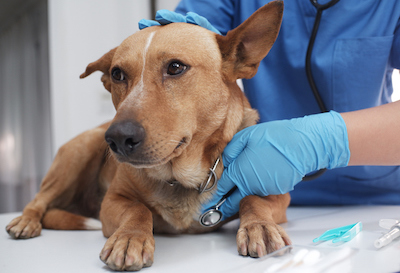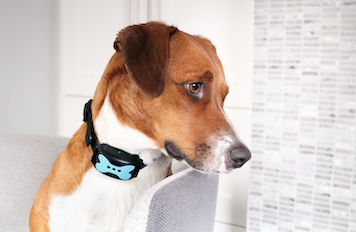Taking your dog to routine vet visits is something every pet parent does to keep their dog happy and healthy. However, these vet visits can be incredibly stressful and challenging if your dog is touch-sensitive. It might already be a struggle for you to put the necessary gear on your dog and get them in the car to go to the vet. The struggle continues once you arrive and another person has to touch your dog when they’re already fearful of their own owner’s touch. You might wonder how on earth you’ll ever be able to get your dog’s nails clipped, ears examined, or temperature taken without putting others, including yourself, at risk and making your dog extremely uncomfortable.
After creating treatment plans for hundreds of touch-sensitive dogs, I’m here to help you better navigate the challenging behavior of touch sensitivity. Sedatives are not the only solution for touch-sensitive dogs. In fact, they can often make the next veterinary visit even more difficult. With proper management and behavioral training, you can treat your dog’s touch sensitivity. First, let’s understand a little more about the behavior and what as a pet parent you should watch out for.
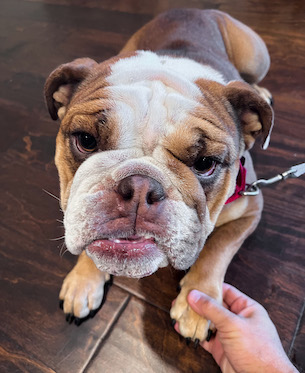
Why Is My Dog Flinching When I Pet Them?
If your dog is flinching when you or other family members reach to pet them, your dog might be touch-sensitive. By touch-sensitive, I mean overly sensitive to touch and showing signs of fear or aggression when handled in certain contexts. Common contexts for dogs to be touch-sensitive include going to the vet or groomer, having a harness or collar put on or taken off, and getting woken up while on a bed or couch.
Your dog might flinch followed by an aggressive behavior such as a growl, snap, or bite. Your dog might also act avoidant and shy away from you looking in the opposite direction or slowly lick your hand. Both of these actions are your dog’s way of asking you to please stop touching them. Many dogs that are touch-sensitive also tend to resource guard as the behaviors are highly correlated.
Common Examples of Touch-Sensitivity
- Subtly avoids being petted—-slightly moving head away when reached for
- Pulling paws away during paw wiping or paw examination
- Jumping up looking alarmed when hindquarters are touched
- Avoiding being picked up
- Startled when woken up
- Stiffening when having equipment like harnesses put on
What Parts of a Dog’s Body Are Especially Sensitive to Touch?
- Paws, especially back paws
- Hindquarters
- Ears
- Head
So Why Is Your Dog Touch-Sensitive?
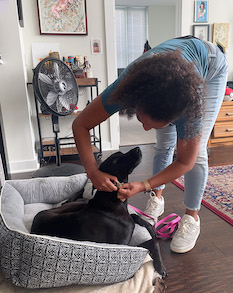
Harsh Training Techniques
Has anyone ever told you that you need to be the alpha to get your dog to listen to you? Methods of training have involved asserting force over a dog in order to establish “dominance,” forcing a dog into “submission.” While these old methods are outdated and not founded in science, there are trainers and other professionals still giving dominance-related advice to unknowing owners. Some are left to think they need to pin their dog to the ground, sometimes even biting their dog, in the hopes that their dog suddenly submits to them and obeys their every command!
These methods are not only inhumane and ineffective at treating problem behavior, they also have the tendency to cause touch sensitivity. As you can imagine, being randomly pinned to the ground and aggressively handled produces fear of hands, and often times an aggressive response is returned. In addition to asserting fear and dominance over a dog, shock, throw chains, and stringing dogs up and off the ground produce unwanted fear and aggression, including in the context of being touched.
Puppy Risk Factors
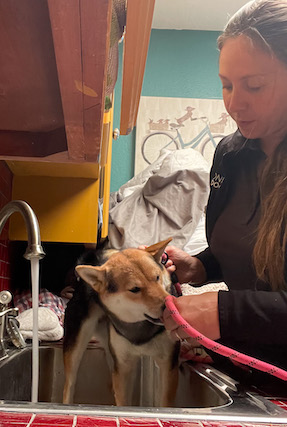
In some cases, trainers and pet parents take a much less aggressive approach, but sadly end up producing similar behavior. In an attempt to socialize a puppy to being handled, pet parents are given the advice to “mess” with their puppy’s collar, paws, ears, or other body parts. If a puppy is more fearful, they are instructed to touch even more frequently. In these cases, exposure alone is ineffective and insufficient. As a puppy, if your dog was not exposed to body handling exercises, they never explicitly learned that human touch was something pleasant.
With body handling exercises, you teach your puppy touch is a good thing by capitalizing on classical conditioning. Basically, you give them a treat every time you gently touch a part of their body like a paw or an ear. When practicing body-handling exercises, be sure to pay attention to each body part. Back paws tend to be more sensitive than front paws because many people only focus on the front paws of a puppy because they are closest. If all paws are given equal attention, the back paws will not be especially sensitive. By practicing body handling exercises you take control of your puppy’s experience being handled and are proactive in avoiding touch sensitivity before it develops.
In some cases, puppies are at risk for touch sensitivity before they are even in their forever home. Early risk factors include if your puppy was housed in tight quarters such as at a puppy mill or pet store, if your puppy was taken from their litter before 8 weeks of age, or if your puppy was raised with little to no littermates. To avoid these risk factors, adopt from a breeder or rescue group that keeps the puppy’s litter together until they are at least 8-9 weeks of age. Also, make sure that the puppies are housed indoors and that they are properly socialized.
Past Abuse
In some extreme cases, rescue dogs come from less-than-ideal situations where they experienced horrific abuse. Many of these dogs have been kicked, have had objects thrown at them, and some have even been shot. Awful situations like these cause dogs to be fearful of humans touching them because of their history of trauma.
Distinguishing the Difference Between Touch Sensitivity and Redirection
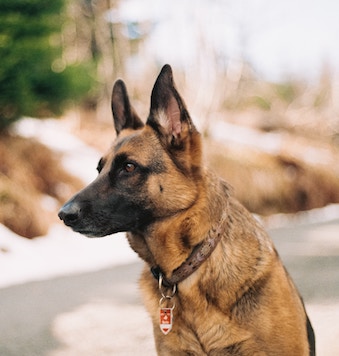
Sometimes it can be challenging for pet professionals to determine the difference between touch sensitivity and redirection. Now that you have a good working definition of touch sensitivity, let’s consider a definition of redirection. Redirection is a bite directed at a person or other animal who is near the dog and usually within a few feet, making it similar to touch sensitivity. What distinguishes redirection is that prior to the bite, the dog is already engaging in aggression or fear toward a different target.
For example, if a dog is reactive on leash towards another dog, they may turn and bite their pet parent or the person holding their leash. The dog is behaving aggressively toward another dog and turns, biting the individual closest to them resulting in a redirected bite. For those dogs that engage in redirected aggression, if they are touched while becoming reactive, they are more likely to redirect. In a sense, the touch adds fuel to an existing fire. In these cases, the dog is not engaging in touch sensitivity but rather redirected aggression because of the presence of reactivity directed at the other target (e.g., a person at the front door, a stranger passing in front of the house, another dog on leash) prior to the bite.
Distinguishing the Difference Between Touch Sensitivity and Reactivity
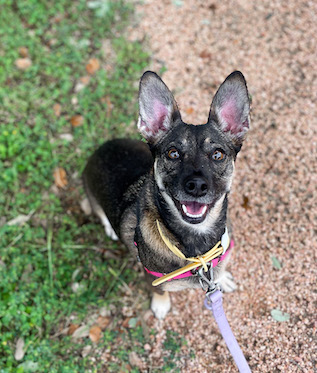
It can be equally challenging for pet professionals to distinguish whether a dog is biting due to touch sensitivity versus reactivity. A dog engaging in reactivity towards people shows aggressive or avoidant behavior in response to seeing new people or being near them. This reactivity often occurs when unfamiliar (to the dog) people come to the home, pass by the home, enter a fenced backyard, or otherwise come into view. The behavior is also prevalent on walks while a dog is on-leash.
Signs of reactivity are visible well before the person is within reach. Signs of reactivity include stiff body language, a hard stare, mouth closed, and potentially barking, growling, lunging, and snapping. In rare cases, these signals are not present until a person is within a touching distance. In these cases, bites often are a result of a person reaching for the dog. In these cases, I consider the behavior reactivity at a very short distance rather than touch sensitivity assuming the following: 1) the dog does not engage in touch sensitivity with familiar people, 2) the dog’s threshold (i.e., how close is too close) is very low, allowing strangers to get close prior to an incident occurring, and 3) there is not a history of unpleasant touches (e.g., grooming, vaccinations, blood draws) from the unfamiliar person.
For dogs engaging in touch sensitivity, reactivity is not present. The act of touching is the concern. Touch sensitivity is directed towards all people, familiar and unfamiliar. In fact, it often occurs mostly with family members given they live closely with the dog. In other touch sensitivity cases, the behavior is directed toward a particular pet professional like a groomer or veterinary care staff due to the dog’s history. Conversely, reactivity is typically directed only toward people a dog is unfamiliar with and tends to be worse with novel individuals.
Why Does My Dog Hate the Vet?
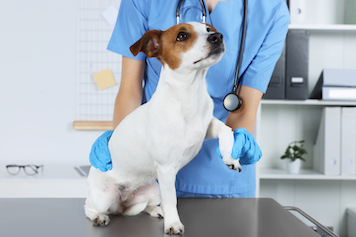
Does your dog seem to hate the one person responsible for helping you keep them healthy? While it may be unfair to the veterinary community, it does seem that dogs have a dislike for going to the doctor. Unfortunately, due to the nature of their work, veterinary staff are often assigned the tasks that come with making your dog uncomfortable and even experiencing pain. Just like all of us, dogs can be more sensitive to others when it comes to pain. For those more sensitive to pain, a difficult injection, blood draw, or examination can serve as an early indicator that veterinary visits are scary.
That first vet experience paired with the distinct veterinary clinic signals like the office setup, sounds, and smells, signal to your pup that a painful or scary thing is about to happen. These environmental signals are often things we overlook or don’t experience ourselves. It is important to consider your dog’s sense of smell and their ability to attend to things that are not obvious to us. Things like stress hormones or even bodily fluids can serve as stressors on their own. Your dog’s medical history, their individual history at any veterinary clinic, and the clear signals of a veterinary clinic all contribute to a dog’s fear of going to the vet.
How to Have the Best Possible Veterinary Experience
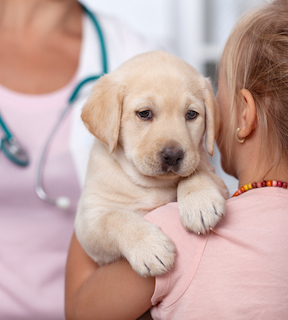
The good news is that you can do a lot to help your dog become comfortable at the veterinarian. And, I’m sure the veterinary team will thank you! Arrive early to your appointment and be well-equipped with treats. I recommend bringing at least three different types of treats at varying degrees of tastiness. For the very food-motivated dog, things like their regular food will suffice as one of the lower-valued items. Chicken jerky, liver treats, or other small treats usually work for something a bit more valuable. Then, I recommend bringing chicken or something of similar value for times of more elevated stress.
As you enter the clinic, start offering lower-value items like their regular food. If your dog is not readily taking the dog food, switch to the medium-value treats. Save the tastiest treats for when your dog is being handled by the veterinary staff. For each new experience or each new body part that the vet handles, give your dog plenty of treats.
If your dog is showing signs of touch sensitivity or you’re concerned about your dog’s experience at the vet, I recommend checking out fear-free veterinary clinics. Fear-free vets place extra emphasis on making sure that your dog has as little stress and fear as possible during their visit. If they notice that your dog is uncomfortable or stressed with a certain procedure, they will do their best to avoid unnecessary stressors. Fear-free vets receive an additional certification that sets them apart from regular vets. Most big cities have plenty of fear-free vet options that you can research.
How Can You Help a Dog Learn To Like Being Touched?
Body-handling exercises are critical when first bringing your puppy home. Unfortunately, touch sensitivity only gets worse with age so if you notice any signs of touch sensitivity in your dog or puppy, it’s best to address the problem right away.
Behavior Modification Training
The good news is that with proper behavior modification, touch sensitivity can be treated. I recommend contacting a local Certified Applied Animal Behaviorist who specializes in the treatment of serious problem behaviors such as touch sensitivity.
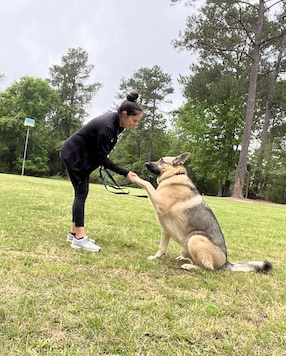
For those pet parents interested in personalized training with Beyond the Dog, we have designed programs to specifically treat touch sensitivity. During these programs, your dog will learn through classical conditioning that good things happen when they are touched. Your trainer will do various training exercises with your dog, mock grooming and veterinary exercises, and collar exercises to equip you and your dog with all the tools you need to be successful.
Your trainer will also teach your dog relevant obedience commands that you’ll be able to use in everyday situations in which touch sensitivity was previously prevalent. At the end of your program, your trainer will give you detailed instructions on everything you need to practice with your dog in order to maintain their level of training post-program.
During training, you should already be able to see a difference in your dog’s behavior within the first week with the problem behavior completely eliminated a little after one month. Your trainer can also attend a couple of veterinary or grooming appointments with you if that makes you feel more comfortable.
I hope your dog’s touch sensitivity is now more easy to navigate. If you have any questions about touch sensitivity or our in-home training programs in Austin, Dallas, Houston, and Kansas City, you can schedule a call with our Co-Founder Sean Savage! During your free consultation, Sean will determine your best course of action in addressing your dog’s touch sensitivity or any other problem behavior.
*This page contains Amazon affiliate links. If you choose to purchase after clicking a link, we may receive a commission at no extra cost to you.*
